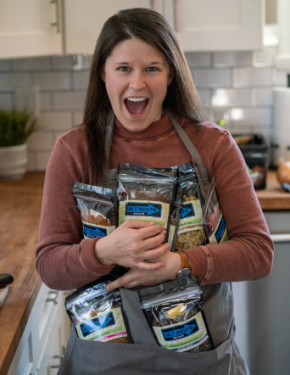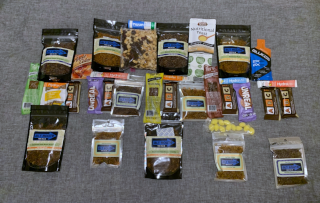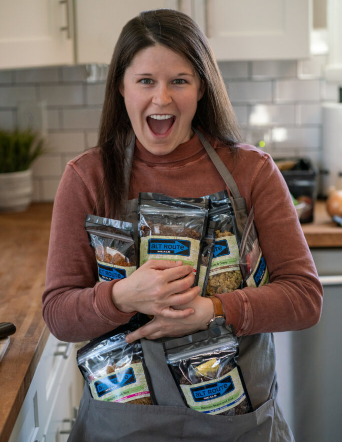
So, you have done your research and finalized the route. You have watched endless YouTube videos and IG Reels about why this pack is better than that pack. You know why freestanding tents are a better bet over hammocks for this route. You even know the exactly puffy you will need for those cold nights. But you may have put off the most important part of the entire trip until the last minute:
The food!
Alt Route Meals is here to help! Nutrition is crucial to any athletic endeavor, and it is all too often an afterthought.
We have spent years sleeping in the dirt thinking about the next meal we get to shove into our mouths to satisfy that unrelenting hunger. It is bizarre how much time you spend fantasizing over the next meal when you are on your hiking, biking, paddling, or climbing trip.
In part, that is why Alt Route Meals was born. We knew that there had to be a better, cleaner option. We would like to share some of the tricks and tips we have learned on our adventures over the years that have become our playbook in all things plant-based food.
The image below showcases the food I am packing for my 77 mi Thru-Hike of the Foothills Trail in South Carolina. I am tackling the hike in late October/early November. As the temperatures drop, extra calories are a must to fuel you on those long, cold, and possibly rainy days.

Breky
For Breakfast, I will be eating (3) different Alt Route Meals over five days along with a cup of Green Tea/ Earl Gray Tea.
- Southwest Hash Brown Scramble: (single serving) 390 calories.
- Garden Couscous: (sample serving) 230 calories.
- Black Beans and Rice: (sample serving) 230 calories.
- Oatmeal with dried fruit. Make your own at home. The store-bought ones are full of sugar!
- Bobo Bars/ Cliff Bars. These are also made primarily out of oats, which give you good, slow-burn energy, but are often higher in sugar than you need first thing in the morning.
Snacks/ Lunch
My strategy on backpacking trips is to
snack every 1-2 hours and graze all day rather than stop for a big lunch. During snack times, I only consume about 150-200 calories depending on my hunger level. For this trip, I am trying out some new snacking options to see how I like them.
- ABC bars from Trader Joe’s: 200 calories
- Primal Spirit Vegan Jerky: 125 calories
- Unreal Dark Chocolate & Almond Butter Cups: 240 calories/cup
- Heather’s Choice Packaroons: 160 calories
- Homemade Trail Mix: Cashews, Salted Peanuts, 80% dark chocolate Chip, Dried Cranberries, Dried Cherries, Dried prunes. I don’t know the calories, but I usually eat 1-2 handfuls on snack breaks.
- If I need a boost, I have a couple more sampler sized Alt Route Meals that I can stop and cook.
- Electrolyte Mixes: I will drink 1 of these per day. My preferred brands are Nuun, Superior Electrolytes, and Mio.
Dinner
Dinner is usually the biggest and most exciting meal of the day.
I daydream about it for the last 2-3 hours before I get to camp. On this trip, I will eat exclusively Alt Route Meals. I know that these are the cleanest meals on the market, and the only thing I have to do is boil water. For a trip like this where I will be averaging 20 mile days for 4 days straight, I need a great, high-calorie meal at the end of the day. I am sticking to (2) flavors for this trip.
- Garden Couscous: 690 calories/11g Fiber/ 18g protein. Includes: (1) cold-pressed organic coconut oil packet and (1) sriracha packet that will add even more calories.
- Black Beans and Rice:680 calories/35g fiber/31g protein. Includes: (1) cold-pressed organic coconut oil packet and (1) tapatio packet that will add even more calories.
For the Beans and rice, I usually pack out tortillas, fritos and occasionally an avocado for some top-of-the-line burritos!
Dessert
- Hot Apple Cider
- Dark Chocolate
The only thing that I am packing for this trip is a couple of hot apple cider packets. The other thing I ever eat for dessert is dark chocolate, but on this trip, I think I will have plenty of calories coming in from elsewhere. Hopefully, Alt Route Meals will be coming out with a desert in the future, hint hint 🙂
As a plant-based athlete, sometimes it can be challenging to figure out what to pack that is both appealing and nutritious on your trips. Unfortunately, packing fresh fruits and veggies is not conducive to pack weight, Leave-No-Trace Principles, or practicality. I hope you can use this as a guide for your first couple of trips until you discover more of what works for you.
Happy trails!
– Hope Westall


Thank you so very much as a Vegan with a growing interest in survivalist skills your info should be invaluable.
Of course! Glad the blog is helpful ?